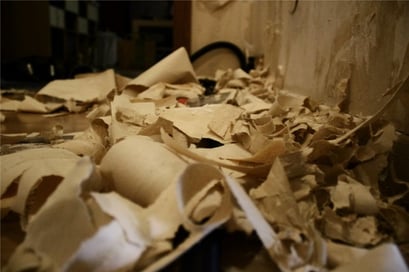 This should be the shortest blog post I've ever written since we have a pretty simple rule at ImageWorks Painting when it comes to painting over wallpaper -- don't do it. Enough said, thanks for reading.
This should be the shortest blog post I've ever written since we have a pretty simple rule at ImageWorks Painting when it comes to painting over wallpaper -- don't do it. Enough said, thanks for reading.
Well, I wish it were that straight-forward but the problem is that many people don't have any desire to go through the time-consuming and potentially labor-intensive process of wallpaper stripping. The reason why most reputable painting companies won't paint over your wallpaper is that the odds of it turning out well are not great. But many folks insist so, in spite of my best judgment, this week's post will be about what I would do if I were to paint over wallpaper at my own home.
Cleaning The Paper
There's a bit of a Catch-22 situation when it comes to cleaning your wallpaper for painting. It's generally not a good idea to introduce a lot of water to the surface of the paper as it can cause the adhesive backing to loosen and the edges to curl. You may get away with just lightly wiping dirt off the walls with a damp cloth but in some areas, especially kitchens and bathrooms, you're likely to encounter grease, nicotine residue, or even mold/mildew that will need to be dealt with.
Cutting Grease & Nicotine
You can't paint over grease and nicotine so you'll have to roll the dice and clean it. The key is to use a heavy-duty cleaner so you're limiting the paper's exposure to water. One of the best cleaners for this situation is TSP (Trisodium Phosphate) powder, which is mixed at a ratio of 1/4 - 1/2 cup of powder to 2 gallons of hot water.
Removing Mildew
By adding some household bleach at about 1 part bleach to 3 parts TSP solution, along with some elbow grease, you'll have a cleaning mixture that can effectively neutralize and remove mildew so it can be painted over.
Regardless of whether you use bleach in your mixture you will need to thoroughly rinse the surface with clean water and a sponge until all cleaning residue is gone.
Give the paper several days to dry and you should know if you're going to have any curled edges to repair.
Uncurling Edges
Painting over curled edges will not cover them up, so if you don't want to see them when your project is done you'll have to do something about it. Wallpaper Seam Repair by Roman Products is a strong wallpaper adhesive that comes in a small squeeze tube to make it easy to apply behind raised seams.
Remove any dirt from behind the edge of the paper, then apply the adhesive in a thin, even coat. Press and smooth the edge into position using a wallpaper seam roller. Wipe off any excess that pushes out from the seam immediately with a damp cloth.
One word of caution when using this type of strong adhesive. If you do decide to remove the paper down the road, this is not a strippable type of adhesive and it will likely cause some damage to the drywall surface underneath when the paper is removed that will have to be repaired. But hey, we're already going against conventional wisdom by doing this in the first place so it is what it is.
Getting Paint To Stick
This step can kill two birds with one stone. First off, you need some type of primer to promote adhesion of the paint to a surface that doesn't lend itself well to the task. Secondly, unless you intend to use oil-based paint for your topcoats you'll need to create a barrier between the latex paint and the wallpaper, otherwise you run the risk of causing the paper to lose it's grip on the wall.
A good oil-based primer/sealer, such as Sherwin-Williams ProBlock Interior Oil-Based Primer, will work well for both purposes. If you've never applied an interior oil-based paint or primer over a large area you'll soon learn that it's not the most pleasant experience, albeit a necessary one if you don't want your latex topcoats to wet the wallpaper glue and the paper to come loose from your walls.
Just apply a coat of your oil-based primer/sealer the same way you would apply regular latex paint, using a 1/4" - 1/2" thick (depending on how heavily textured your surface is) nap synthetic or mohair roller cover and a natural bristle paint brush. You'll need some mineral spirits (paint thinner) for cleaning up as oil-based products do not clean up with soap and water.
Finishing The Job
Some of the experts recommend applying a bead of clear paintable caulking along the perimeter of the room where the walls meet the ceiling as they claim it will help to seal down the edges. Be sure to smooth out the bead with your finger.
Finally, just apply two coats of your favorite latex paint and you should be good to go.
Although painting over wallpaper is not something that we recommend, this is the best way I know of to go about the task.
If you live in the Greater Tampa, Fl area and would like some assistance with your house painting project please give us a call at (813) 570-8800, visit our Contact Us page, or click on the button below to request your free, no-obligation consultation and quote.

Photo by: Christophe Goessen / CC BY 2.0







 This should be the shortest blog post I've ever written since we have a pretty simple rule at ImageWorks Painting when it comes to painting over wallpaper -- don't do it. Enough said, thanks for reading.
This should be the shortest blog post I've ever written since we have a pretty simple rule at ImageWorks Painting when it comes to painting over wallpaper -- don't do it. Enough said, thanks for reading.
